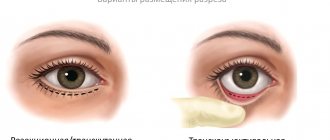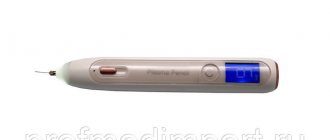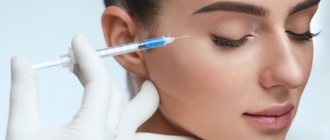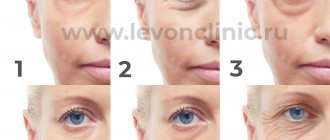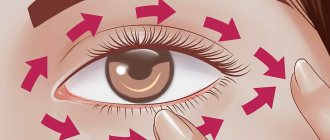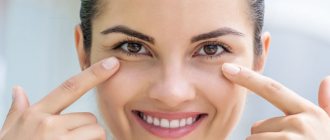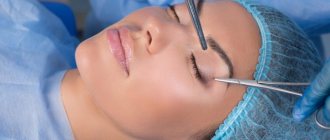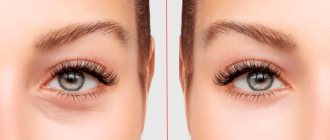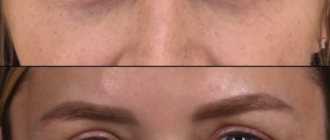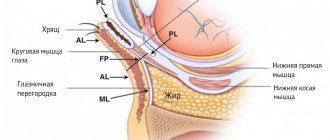Plasma blepharoplasty in Moscow
Who wants to look beautiful and young for as long as possible? Of course, anyone will answer positively to this question.
However, if before the age of thirty, in order to eliminate skin imperfections and get rid of wrinkles, it is enough to apply special creams and gels, then after forty years, in order to say goodbye to bags under the eyes, puffiness, and wrinkles, many decide to undergo surgery.
This operation is called blepharoplasty.
It can be performed under either general or local anesthesia. Surgical intervention is quite expensive and entails a significant recovery period. Today, the Cellulite clinic offers you an excellent alternative to surgical blepharoplasty - this is non-surgical plasma blepharoplasty.
To carry out the procedure, we use a unique medical device - PLASMAGE, which uses the phenomenon of plasma (plasma consists of ionized gas, includes ions and electrons, while the substance is completely neutral).
The plasma generated by gas ionization creates a lifting effect, causing renewal of surface tissues.
The device works as accurately as possible, without affecting the deep layers of the skin and without affecting the surrounding tissues.
Pinch method in blepharoplasty
14.05.2019
Doctors at Svoe Clinic use the most modern, proven, minimally invasive techniques. Usually, when talking about lower blepharoplasty, they mention classic and transconjunctival. In fact, there are many more methods. Plastic surgeon Boris Aleksandrovich Kabakov will talk about the pinch method, how it differs from other options for lower blepharoplasty, and in what cases it is used.
The perception of a person almost always begins with the perception of his face. Usually our first impression of a person is formed by his eyes and gaze. We subconsciously evaluate, first of all, the key areas around the eyes. The aesthetic condition of these zones (periorbital areas) depends on many different factors, including:
- eyebrow position;
- condition of the tissues of the temporal zones;
- the presence of intraorbital hernias;
- condition of adipose tissue and supporting structures surrounding the orbit (including bone);
- width, height and axis of the palpebral fissure;
- skin tone.
Therefore, for a “real” anti-aging effect, eyelid surgery alone is usually not enough.
A comprehensive individual approach to achieving aesthetic correction is required - a combination of surgical and cosmetic techniques.
One of the stages of surgical correction may be lower blepharoplasty, which is performed under both local and general anesthesia. Schematically and most often, blepharoplasty involves the elimination of excess skin, excision or redistribution of orbital fat packets, strengthening of the structural tissues of the eyelid (orbicularis muscle, septum, canthal ligaments). The most commonly used approaches to the internal structures of the lower eyelid are subciliary (percutaneous incision) and transconjunctival (from the inside of the eyelid). The main problem of the subciliary approach is the approach to the fat packets with the inevitable dissection of the orbicularis muscle and the underlying septal septum. This increases the risk of developing inversion of the lower eyelid margin in the postoperative period due to destabilization of the support and a scar process that pulls the eyelid downward. Therefore, this kind of intervention requires additional “safety net” manipulations - myopexy and/or lateral canthopexy.
Traditionally, the transconjunctival approach is used in cases where there is no excess skin of the lower eyelids. However, many surgeons today use this approach in most cases as it is less invasive. In this case, excess skin is carefully removed using the pinch technique (pinch - from English “pinch off”). Fatty hernias are removed from the inside (transconjunctivally = through the conjunctiva), excess skin is removed from the outside, and the orbicularis oculi muscle is not affected. If necessary, canthopexy is performed. This approach to eyelid correction significantly shortens the rehabilitation period and reduces the risk of developing ectropion of the lower eyelid margin.
However, the choice of technique is individual and depends on hundreds of reasons.
To make an appointment with Boris Alexandrovich Kabakov, call 8 or email the clinic
10
0
Application of plasma in aesthetic medicine
Procedures using plasma help initiate the processes of skin regeneration and rejuvenation.
Specialists non-invasively remove not only wrinkles in the eye area and skin imperfections in this area, but also remove various tumors, and also eliminate age spots. One of the advantages of using plasma is that the patient can go about their daily activities the very next day.
Among other things, plasma blepharoplasty has an antibacterial and anti-inflammatory effect.
Blepharoplasty - eyelid surgery
Every person has fatty tissue in the lower eyelid area. The skin itself is thin - about four times thinner than the rest of the facial skin. With a decrease in skin tone, fat appears in the form of characteristic hernias. In addition, fluid can accumulate in the fatty tissues of the eyelids. Its excess increases swelling of the eyelids.
People with bags under their eyes are often suspected by those around them of secret vices, of an immoderate passion for alcohol. Their appearance evokes thoughts, at a minimum, of physical ill health. Sometimes swollen lower eyelids actually indicate poor kidney or heart function. But the same bags under the eyes may not be related to diseases of the internal organs and are predetermined by hereditary factors.
The circumstances why fatty hernias protrude more strongly can be very different. It happens that the body reacts in this way to allergic substances, but most often the fat around the eyes becomes more noticeable because the skin of the face loses its elasticity. Internal aging processes, despite all the efforts of cosmetologists, take their toll.
You can help. Surgery to remove fatty hernias is called eyelid surgery.
or
blepharoplasty
. It takes place under light intravenous anesthesia and usually lasts 30-40 minutes. There are several options for the operation. If the skin of the eyelids is clearly stretched and there is excess of it (usually in older people), the surgeon removes or moves the fatty tissue through a mini-incision directly under the ciliary edge of the eyelid. To achieve an ideal result, it is sometimes necessary to strengthen the muscle layer of the eyelid. The surgeon then slightly tightens the sagging skin of the lower eyelids and removes excess skin. The postoperative thin scar initially looks like a small reddish scratch, then quickly fades and becomes completely invisible.
If the skin of the eyelids and the orbicularis oculi muscle have not undergone noticeable changes (usually in young people), fatty hernias are eliminated transconjunctivally: through a mini-incision on the side of the mucous membrane of the eyelid. In this case, traces of the operation are not visible at all. Finally, if the patient has slight excess eyelid skin, the plastic surgeon may combine transconjunctival surgery with laser eyelid skin peeling. Laser pulses cause a noticeable contraction of the collagen fibers of the skin, as a result of which it tightens and becomes elastic again. In any of these options there are a lot of nuances that allow the surgeon, working with a specific patient, to achieve the best aesthetic result.
Contraindications: Pulmonary, heart failure Chronic diseases of internal organs in the stage of decompensation/exacerbation Acute diseases Diabetes mellitus in the stage of decompensation Oncological diseases Presence of blood-borne infections Pregnancy, lactation Mental illness Planning pregnancy in the next 12 months Increased intraocular pressure Dry eye syndrome
Patients do not feel pain either during or after the operation. The only cause of discomfort is swelling, the degree of which varies from person to person. They can last up to 7 days. After blepharoplasty, some patients develop small bruises under the eyes, which disappear after 10-12 days. The patient is discharged from the hospital the next day after the operation and after another 1-2 days the stitches are removed.
After removing fatty hernias under the eyes, a person looks strikingly refreshed and rejuvenated. It is impossible to guess the true reason for the change that has occurred, unless he himself considers it necessary to tell the truth to his relatives or friends. By the way, you can get rid of unsightly bags under your eyes for a long time even when they are caused by kidney or heart diseases.
Blepharoplasty often complements corrections such as endoscopic face lifting, rhinoplasty, liposuction, abdominoplasty, breast surgery: breast augmentation or breast reduction, as well as some other operations.
How to get advice?
Reception of plastic surgeons is free - on weekdays from 10 to 18 hours (on Thursdays - from 12 to 18 hours), on Saturdays - from 10 to 16 hours by appointment by phone.
If you live not in Yekaterinburg, but in another city in Russia, we conduct consultations remotely, using photographs. Please read the terms and conditions for receiving a remote consultation on the “How to get a consultation” page.
ATTENTION! Smoking negatively affects the outcome of the operation, causing serious complications such as tissue necrosis. If you smoke, you must quit smoking 2 months before surgery.
THERE ARE CONTRAINDICATIONS, SPECIALIST CONSULTATION IS REQUIRED
Benefits of plasma blepharoplasty
— plasma blepharoplasty is suitable for all skin types, it has virtually no side effects; - use of local anesthesia; - does not cause bleeding; — effect after 1 procedure; — the rehabilitation period is insignificant.
Photos before and after the procedure
Non-surgical plasma blepharoplasty. Eyelid skin tightening without incisions using the Plexr device.
Eyelid surgery can be performed in different ways.
The main indication for this operation is the appearance of sagging eyelid skin, the formation of skin bags and drooping of the outer corner of the eye. Until 2008, blepharoplasty was performed only with a scalpel. Traditional surgery is performed under anesthesia and always leaves a mark in the form of a postoperative scar.
The Plexr device allows you to perform eyelid surgery - blepharoplasty using plasma without anesthesia and incisions, without health risks and scars on the skin.
Rice. 1. Non-surgical plasma blepharoplasty
Progress of the procedure
The procedure for correcting deficiencies in the periorbital area lasts, on average, 15-30 minutes. The specialist applies an anesthetic cream to the affected area. Then the mode and radiation power that is ideal for the patient are selected.
After the procedure is completed, the effect is immediately visible.
There may be slight swelling of the treatment area and redness of the skin. Experts recommend taking care of the treated area (applying compresses, applying special creams), and wearing sunglasses. Complete restoration of the skin occurs, on average, after 4-6 weeks.
The procedure can be performed at any time of the year, regardless of the patient’s age, skin type and color.
How easy is the operation?
In my practice, I often note from patients who come to me with complaints about the appearance of the lower eyelids, a certain question: how does your lower blepharoplasty differ from the operations performed by other surgeons. At first glance, nothing special: the same incision under the eyelashes (now I’m not talking about the transconjunctival approach, when the incision is on the inside of the lower eyelid, not on the skin), heals quickly, a friend who had lower blepharoplasty had exactly the same thing... And you talk about some kind of paint “bags”, about some “pexies”, when I came just to remove the “bags” under my eyes, well, in general, to make it look like a friend’s.
The patient is 28 years old; good skin quality allowed lower blepharoplasty to be performed through the conjunctiva.
Of course, you can remove “bags” under the eyes. This is how they used to do it: the operation consisted of a simple resection of three infraorbital fat hernias and excision of a strip of excess skin. And the result of the operation depended on whether the patient was lucky with him or not. So what does the result of lower blepharoplasty ? I want to tell you in this article.
For me, as a plastic surgeon operating on the eyelids, the first priority during a consultation is to determine the state of the tone of the lower eyelid. This is a key indicator in terms of choosing a surgical method and achieving long-term aesthetic results. The tone of the lower eyelid is determined by several techniques that can help you get an idea of the state of the external and internal canthal ligaments and the orbicularis oculi muscle. This indicator cannot be ignored, otherwise after the operation there may be consequences in the form of a “round” eye, when the incision changes into this rather unsightly shape.
A patient after two blepharoplasty operations. Unsatisfied with my lower eyelids. Reoperation: temporal lift, lower blepharoplasty with canto-and-myopexy, lipofilling of the lower edge of the orbits. Notice the smooth transition of the eyelid to the cheek (no circles under the eyes) and the outer corners of the eyes, which have become sharp instead of rounded.
The second most important thing during examination is the condition of the skin of the lower eyelids. The skin on the eyelids is very thin and is susceptible to external influences such as sun rays, air temperature, and sometimes we don’t even notice how much we mechanically stretch the skin when we rub “specks” in our eyes. I evaluate excess skin on the eyelids, skin thickness and elasticity, i.e. the ability to quickly smooth out, for example, when pinched, the presence of wrinkles, pigment, “dark circles”, etc. This skin assessment will determine which approach is chosen, through the conjunctiva or through the skin, or whether both approaches are used.
The third circumstance that I always draw the patient’s attention to is the state of the paraorbital zone of the face. Regarding the lower eyelids, this refers to relief, shadows and irregularities in the form of furrows under the eyes, when a V-shaped depression appears under the eye, or pronounced “painter bags”, which patients often confuse with fatty hernias. The presence of these age-related changes on the face requires extended operations, where lower blepharoplasty acts as one of the stages of the operation and certainly in an isolated form will not eliminate these shortcomings and will not solve all the tasks.
Patient 35 years old. Lower blepharoplasty was performed through the subciliary approach, fatty hernias were not removed, they were redistributed along the lower edge of the orbit, lateral canthopexy and myopexy. Pay attention to the perfectly smooth transition between the eyelid and cheek in the “after” photo.
The fourth, very important conclusion during examination is the position of the lower bony edge of the orbit relative to the eyeball, whether the eye protrudes forward beyond the edge or not. We evaluate this indicator using the so-called negative or positive vector. Taking this vector into account, during surgery the use of special technical techniques and methods, such as lipofilling, chick-lifting, implants, allows one to achieve better aesthetic results.
Of course, each patient has his own treatment tactics. So, for young people with no excess skin of the lower eyelids and with good skin elasticity, transconjunctival lower blepharoplasty is indicated, when simply fatty hernias are resected, the skin shrinks and the patient thereby acquires a refreshed appearance.
If excess skin is present, with good eyelid tone, transconjunctival lower blepharoplasty can be combined with an additional incision under the eyelashes and excision of excess skin.
Severe age-related deficiencies of the lower eyelids require an expansion of the operation, which consists of restoring the tone of the canthal ligaments of the eyelid, tightening the orbicularis oculi muscle, eliminating the relief of the macular “bags” and grooves under the eyes, moving and redistributing fatty hernias of the lower eyelid, and chick-lifting.
Patient, 32 years old, underwent lower blepharoplasty with transconjunctival redistribution of fatty hernias and excision of excess skin through a subciliary incision.
From the above, we can conclude: lower blepharoplasty is an operation that can be simple or complex, may include one or more technical techniques, or be only one of the stages of an integrated approach to rejuvenating the lower eyelids and surrounding paraorbital areas. And of course, the result will depend on the surgeon, on his experience, on his ability to diagnose the condition of the eyelids and the correct choice of surgical treatment tactics and on the technical capabilities of the execution. I return to the question at the beginning of the article and answer it - lower blepharoplasty cannot be a simple procedure and a simplified standard approach to its implementation is in no way applicable under any circumstances, no matter who would offer it to you at any price.
Plastic surgeon Alexander Leonidovich Katkov, chief physician of the Med-Est clinic.
How simple is the operation part two
What is the price
| Non-surgical wrinkle correction Price list | ||
| Price | Promotion | |
| Eyebrow area | 10,000 rub. | 7,000 rub. |
| Forehead area | 10,000 rub. | 7,000 rub. |
| Crow's feet | 10,000 rub. | 7,000 rub. |
| Upper eyelids | 20,000 rub. | 15,000 rub. |
| Lower eyelids | 15,000 rub. | 12,000 rub. |
| Cheeks (fine wrinkles) | 10,000 rub. | 7,000 rub. |
| Neck | from 10,000 rub. | from 7,000 rub. |
| Cleavage | 20,000 rub. | 18,000 rub. |
| Post acne treatment whole face | 105,000 rub. | 10,000 rub. |
| Treatment of post acne lower third of the face | 10,000 rub. | 7,000 rub. |
| 1 element | 1,000 rub. | 700 rub. |
| Treatment of scars, stretch marks | from 1,000 rub. | |
Price Promotion: Eyebrow area 10,000 RUR Forehead area 10,000 RUR Crow's feet 10,000 RUR Upper eyelids 20,000 RUR Lower eyelids 15,000 RUR Cheeks (fine wrinkles) 10,000 RUR Neck from 10,000 RUR Décolleté 20,000 RUR Treatment of post-acne whole face1 RUB 05,000 .Treatment of post-acne lower third of the face10,000 rub.1 element1,000 rub.Treatment of scars, striaefrom 1,000 rub.
Non-surgical laser blepharoplasty Contour TR
We present an exclusive procedure performed using the latest Contour TRL laser module - weekend blepharoplasty. The rejuvenation technique involves the doctor using a laser tip to accurately and accurately treat the fold of the upper and lower eyelids and the periorbital area. After the procedure, there is a significant reduction in drooping eyelids and protruding hernias, smoothing out wrinkles in the eye area. Contour TRL is a unique SMART system that extremely accurately controls the depth of treatment and allows you to individually select settings for each patient. The procedure takes within 20 minutes and leaves behind only slight swelling and redness. After slight peeling has passed (1-2 days), the patient can evaluate the first results of the procedure, which subsequently increase.
Our clinic uses several laser blepharoplasty protocols - “delicate” and more complex. The quality and results do not differ from each other, the only caveat is that “delicate” procedures are recommended to be performed more often.
Non-surgical blepharoplasty is the most popular procedure today to rejuvenate the appearance of the skin in the eye area.
Your skin is the first to reveal your biological age. This is especially true for the skin of the eyelids, which play an important aesthetic role in the entire appearance. After all, the expression of the eyes is directly dependent on the condition of the eyelids and periorbital tissues. The cosmetic services market offers a number of non-invasive procedures that are designed to radically change and rejuvenate the appearance of the skin.
Non-surgical blepharoplasty, performed using the latest Contour TRL laser module, is an innovative development. Its peculiarity is a high degree of safety and effectiveness; it is “know-how” in the field of non-invasive methods of skin rejuvenation. The Contour TRL scanner allows you to select parameters for a cosmetic procedure depending on the initial condition of the skin and the wishes of the client.
The range of depth of influence of the device on dermal cells is quite wide, ranging from superficial light peeling to deep grinding. Unlike CO2 lasers, non-surgical blepharoplasty using Contour TRL technology allows you to control the depth of ablation and the degree of coagulation within a given range.
Non-surgical lower eyelid blepharoplasty at the Real Clinic is performed using a modern Contour TRL device. This is an innovative procedure based on the use of laser technology. The technique is painless, makes it possible to adjust the depth and degree of impact individually, and the result is simply amazing!
The laser beam delicately corrects wrinkles, sagging skin in the lower eyelid area, and eliminates all age-related changes. And this takes only 20 minutes, because that’s how long the session lasts. It’s no wonder that Real Clinic patients call laser correction of the lower eyelids using the Contour TRL device “weekend blepharoplasty,” because it allows you to rejuvenate the skin in this area in record time. Make sure of this too!
Eyelid blepharoplasty procedure.
Results in three weeks. Please note that lower eyelid blepharoplasty was not performed.
| Video procedure |
How does it work
Plasma or laser blepharoplasty is a technology of ionization of gas particles in the air between the instrument and the skin, which provides extremely effective skin tightening in plasma.
There is no heat transfer between the tool and the surface of the skin, so there is minimal or no damage. Today, this is the only procedure that removes skin without a single cut, without stitches and with a quick recovery period. Due to its precision, laser blepharoplasty is ideal for removing excess skin around the eyes. Plasma eye lift not only leaves very little damage to the surface, but also has no effect on the underlying tissue. In addition, the procedure also protects the deeper layers of the skin from unwanted heat transfer.
For what purposes is plasma used in medicine?
Indications for plasma skin grafting:
- Restoration of eyelid skin (non-surgical blepharoplasty), including bags under the eyes, excess eyelid skin.
- Tattoo removal.
- Removal of skin defects and skin formations, including warts, fibromas, pigmentation, keratomas.
- Treatment of scars, post-acne, stretch marks.
- Removing wrinkles around the mouth
- Face and neck lift.
- Treatment of active acne.
Plasma allows you to remove excess skin in real time, the result of the procedure lasts for several years. Complications during plasma procedures practically do not occur.
